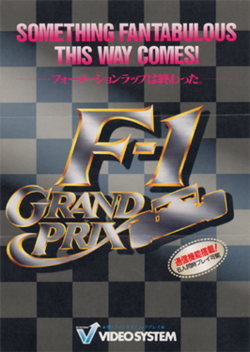
Super Mario Kart is a kart racing game developed and published by Nintendo for the Super Nintendo Entertainment System (SNES). The first game in the Mario Kart series, it was released in Japan and North America in 1992, and in Europe the following year in 1993. Selling 8.76 million copies worldwide, the game went on to become the fourth best-selling SNES game of all time. Super Mario Kart was re-released on the Wii's Virtual Console in 2009, on the Wii U's Virtual Console in 2013, and on the New Nintendo 3DS's Virtual Console in 2016. Nintendo re-released Super Mario Kart in 2017 as part of the company's Super NES Classic Edition.
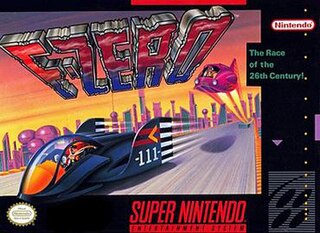
F-Zero is a racing game developed and published by Nintendo for the Super Nintendo Entertainment System (SNES). It was released in Japan on November 21, 1990, in North America in August 1991, and in Europe in 1992. F-Zero is the first game in the F-Zero series and was a launch game for the SNES. F-Zero was rereleased for the Virtual Console service on various Nintendo platforms and as part of the Super NES Classic Edition in 2017.
Racing games are a video game genre in which the player participates in a racing competition. They may be based on anything from real-world racing leagues to fantastical settings. They are distributed along a spectrum between more realistic racing simulations and more fantastical arcade-style racing games. Kart racing games emerged in the 1990s as a popular sub-genre of the latter. Racing games may also fall under the category of sports video games.

Final Lap is a 1987 racing simulation video game developed and published by Namco. Atari Games published the game in the United States in 1988. It was the first game to run on Namco's then-new System 2 hardware and is a direct successor to Namco's Pole Position (1982) and Pole Position II (1983). It was ported to the Famicom by Arc System Works, making it Arc System Works' debut game.

Simulated racing or racing simulation, commonly known as simply sim racing, are the collective terms for racing game software that attempts to accurately simulate auto racing, complete with real-world variables such as fuel usage, damage, tire wear and grip, and suspension settings. To be competitive in sim racing, a driver must understand all aspects of car handling that make real-world racing so difficult, such as threshold braking, how to maintain control of a car as the tires lose traction, and how properly to enter and exit a turn without sacrificing speed. It is this level of difficulty that distinguishes sim racing from arcade racing-style driving games where real-world variables are taken out of the equation and the principal objective is to create a sense of speed as opposed to a sense of realism.

F1 Race is a racing video game developed by HAL Laboratory and published by Nintendo for the Famicom in 1984. A version was released in 1990 for the Game Boy in Japan and in 1991 in Europe and North America, including the Four Player Adapter for four-player gameplay.

SD F-1 Grand Prix is a Japan-exclusive video game based on the F1 Grand Prix series. This video game spin-off was developed for the Super Famicom by Video System.

Ayrton Senna's Super Monaco GP II is an arcade-style Formula One racing video game developed and manufactured by Sega for the Sega Genesis and Mega Drive, Master System, and the Game Gear in 1992. It is a follow-up to Super Monaco GP. The game was also endorsed by, and had technical input from, the then-Formula One champion Ayrton Senna. Gameplay includes a World Championship season featuring recreations of the tracks in the 1991 Formula One World Championship, along with a three-race "Senna GP" mode set on fictional tracks.

Super Monaco GP is a Formula One racing simulation video game released by Sega, originally as a Sega X Board arcade game in 1989, followed by ports for multiple video game consoles and home computers in the early 1990s. It is the sequel to the 1979 arcade game Monaco GP. The arcade game consists of one race, the Monaco Grand Prix, but later ports added more courses and game modes based on the 1989 Formula One World Championship.
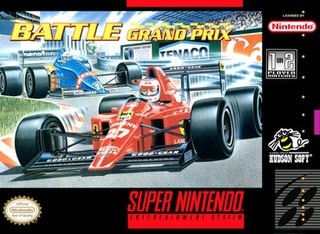
Battle Grand Prix is a 1992 Formula One racing video game developed by KID. One or two players can pit themselves in three Grand Prix races. Each of the different team cars have different color schemes. The courses vary from blacktop to concrete, and rain is also included and is implemented in the game.

F1 ROC: Race of Champions, released in Japan and Europe as Exhaust Heat (エキゾースト・ヒート), is a 1992 racing video game developed by SETA Corporation for the Super Nintendo Entertainment System.
Ever since Pole Position in 1982, Formula One (F1) has always played a part of the racing genre in video games. Early Formula One games were typically arcade racing games, before Formula One Grand Prix (1991) popularized Formula One racing simulations on home computers.

Nakajima Satoru Kanshuu F1 Grand Prix is a 1991 Sega Mega Drive Formula One video game based on the career of Satoru Nakajima, who was the first full-time Japanese racer in the history of Formula One. In fact, this was the first game that Nakajima endorsed for a Japanese video gaming system. The entire 1991 Formula One season can be re-enacted with any of the notable contenders from the prestigious Formula One racing organization.

F1 Pole Position is a 1992 racing video game for the SNES, developed by Human Entertainment and published by them in Japan, while the other versions were handled by Ubi Soft. It is the first game in the Human Grand Prix/F1 Pole Position series, which features Formula One licensing.
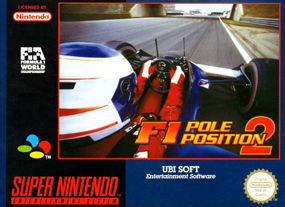
F1 Pole Position 2, known in Japan as Human Grand Prix II, is the sequel to Human Grand Prix and the predecessor to Human Grand Prix III: F1 Triple Battle.
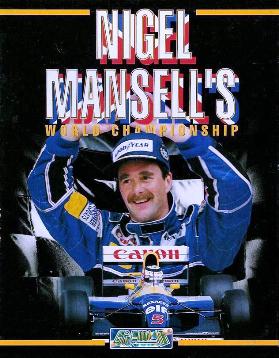
Nigel Mansell's World Championship Racing is an arcade-style Formula One racing video game developed by Gremlin Graphics and released for various systems. The game was largely successful on Amiga and DOS platforms, and was consequently ported to home consoles.

Satoru Nakajima F-1 Hero GB World Championship '91 is a 1991 Japan-exclusive Game Boy Formula One video game published by Varie, endorsed by Satoru Nakajima, who was the first full-time Japanese racer in the history of Formula One. Apart from Nakajima, the actual names of the drivers are not used due to licensing arrangements.

F1 Circus is a series of Formula One-based racing video games developed and published by Nichibutsu starting on the PC Engine in 1990.
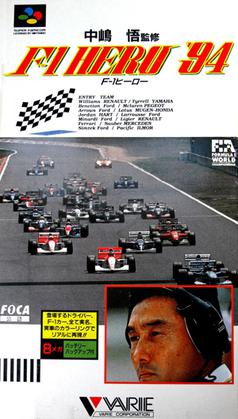
Nakajima Satoru F-1 Hero '94 is a 1994 Japan-exclusive Super Famicom Formula One arcade racing video game licensed by Satoru Nakajima and by FOCA to Fuji Television. This was the sequel to Super F1 Hero and the last game endorsed by Nakajima.
F-1 Spirit is a series of Formula One-based racing video games developed and published by Konami starting on the MSX in 1987.
